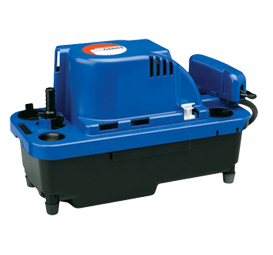Last summer, my husband noticed that something wasn’t working right in our cooling system. He wasn’t sure what it was so we called in a professional. After a quick look, he told us that our condensate pump had gone out. He said it would be an easy fix and that all he had to do was buy a replacement to install. I’m the type of lady that likes to know what is going on and what I’m paying for-so I did some research. This is what I learned.
A condensate pump is installed into a heating and/or cooling system to remove the “water” (condensate) that is produced when the system is running. Since this water is not safe for consumption, it should be drained out away from the home to avoid contamination (luckily ours had a set-up that was easy for the technician to hook up the new pump to).
The pump does not run constantly while the cooling or heating system is on. Instead, there is a tank where the water is collected and when it reaches a certain point, the pump will turn on and start to drain. A float switch on the pump is activated which causes the collected water to be sent out.
The actual pump capacity can range anywhere from half a gallon to one gallon. The water is pumped out by a plastic impeller located at the bottom of the pump. ( I wasn’t sure what an impeller was so I looked it up and as it is explained in the World English Dictionary: the vaned rotating disc of a centrifugal pump, compressor, etc.-which tells me it is sort of like a propeller on a boat). The water travels through PVC pipe to the sewer or some other drain that then takes it to the sewer. Like other pumps, there is sometimes a check valve installed to avoid the water from running back into the pump and causing problems.
Since the condensate that is produced when a heating or cooling system is running may pick up different particles and other foreign objects from the air, it is important to make sure that it is drained and disposed of in the proper fashion (to avoid gross things from happening to our drinking water! Yuck!).
Some pumps have two different stages at which it will be activated. This is done to ensure that if the first stage fails like if the water is not draining at a fast enough rate or not draining at all, that the system will turn off to avoid excess water that can leak and cause water damage.
Once I knew what we were getting, I felt it was wise for us to spend the money to get a replacement pump. The technician that did the job also explained to us that it would help to keep our energy costs low (which makes me one happy woman!). Just a few days back, I was able to go back to my favorite online store and read more about pumps.

